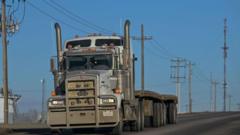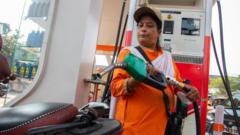In the world of trucking, technology is both a savior and a double-edged sword. For Jared, a Canadian truck driver who has spent over two decades on the road, the landscape of his profession has changed drastically thanks to digital tools. Where he once relied on payphones and pagers to secure jobs moving fruit and wine, he now juggles multiple devices in his truck cabin while transporting musical equipment for a country star.
Jared’s experience highlights the evolution brought on by "Uberised" platforms that connect truckers with shippers in need of freight transportation. However, despite the apparent conveniences, he reveals a troubling reality: decreased wages. “During Covid, the average rate was $3 per mile, but that’s dropped to $1.10 for routes from Toronto to Los Angeles,” he explains, pointing out the substantial increase in fuel costs.
In Canada, an estimated eight major freight platforms, including Uber Freight, are reshaping the trucking industry. These platforms cater to the majority of small trucking companies, with over 80% employing fewer than five workers. Christopher Monette from Teamsters Canada expresses concern over the impact of these digital services on labor, stating, "Wages have remained stagnant for 25 years, and gig-style work threatens to worsen this." His union represents over 130,000 industry workers advocating for better pay and protections rather than reliance on technology.
In response to concerns around wages, a representative from Uber Freight emphasizes flexibility and choice, allowing carriers to select loads based on preferences and negotiate rates. Yet drivers like Jared feel the urgency for meaningful financial support.
Emerging technologies also showcase innovation within the industry. Eric Beckwitt, co-founder of Freightera, a Vancouver-based service, describes his platform’s ability to connect drivers with 20 billion routes efficiently. “Before our tech, finding work was like finding a needle in a haystack,” he says. Freightera allows carriers to set their own prices, a stark contrast to many other platforms.
Globally, the shift towards digital trucking is noticeable. In Kenya, where road freight is paramount, LORI, Africa’s largest digitized freight platform, has dramatically increased operational efficiency by connecting trucks and freight without owning vehicles.
However, while some new technologies seek to increase efficiency and reduce the carbon footprint of the trucking industry, others present potential challenges for the workforce. The development of autonomous trucks, already in testing phases around the world, has inspired speculation about the future of human drivers.
Despite advances in automation, Jared remains skeptical. "Self-driving trucks? We’re not there yet; transportation has existed for centuries, and the human element isn’t going away anytime soon," he asserts. The trucking industry stands at a crossroads, balancing the benefits of digital innovation with the pressing need for better labor conditions and fair wages for its workforce.
Jared’s experience highlights the evolution brought on by "Uberised" platforms that connect truckers with shippers in need of freight transportation. However, despite the apparent conveniences, he reveals a troubling reality: decreased wages. “During Covid, the average rate was $3 per mile, but that’s dropped to $1.10 for routes from Toronto to Los Angeles,” he explains, pointing out the substantial increase in fuel costs.
In Canada, an estimated eight major freight platforms, including Uber Freight, are reshaping the trucking industry. These platforms cater to the majority of small trucking companies, with over 80% employing fewer than five workers. Christopher Monette from Teamsters Canada expresses concern over the impact of these digital services on labor, stating, "Wages have remained stagnant for 25 years, and gig-style work threatens to worsen this." His union represents over 130,000 industry workers advocating for better pay and protections rather than reliance on technology.
In response to concerns around wages, a representative from Uber Freight emphasizes flexibility and choice, allowing carriers to select loads based on preferences and negotiate rates. Yet drivers like Jared feel the urgency for meaningful financial support.
Emerging technologies also showcase innovation within the industry. Eric Beckwitt, co-founder of Freightera, a Vancouver-based service, describes his platform’s ability to connect drivers with 20 billion routes efficiently. “Before our tech, finding work was like finding a needle in a haystack,” he says. Freightera allows carriers to set their own prices, a stark contrast to many other platforms.
Globally, the shift towards digital trucking is noticeable. In Kenya, where road freight is paramount, LORI, Africa’s largest digitized freight platform, has dramatically increased operational efficiency by connecting trucks and freight without owning vehicles.
However, while some new technologies seek to increase efficiency and reduce the carbon footprint of the trucking industry, others present potential challenges for the workforce. The development of autonomous trucks, already in testing phases around the world, has inspired speculation about the future of human drivers.
Despite advances in automation, Jared remains skeptical. "Self-driving trucks? We’re not there yet; transportation has existed for centuries, and the human element isn’t going away anytime soon," he asserts. The trucking industry stands at a crossroads, balancing the benefits of digital innovation with the pressing need for better labor conditions and fair wages for its workforce.





















